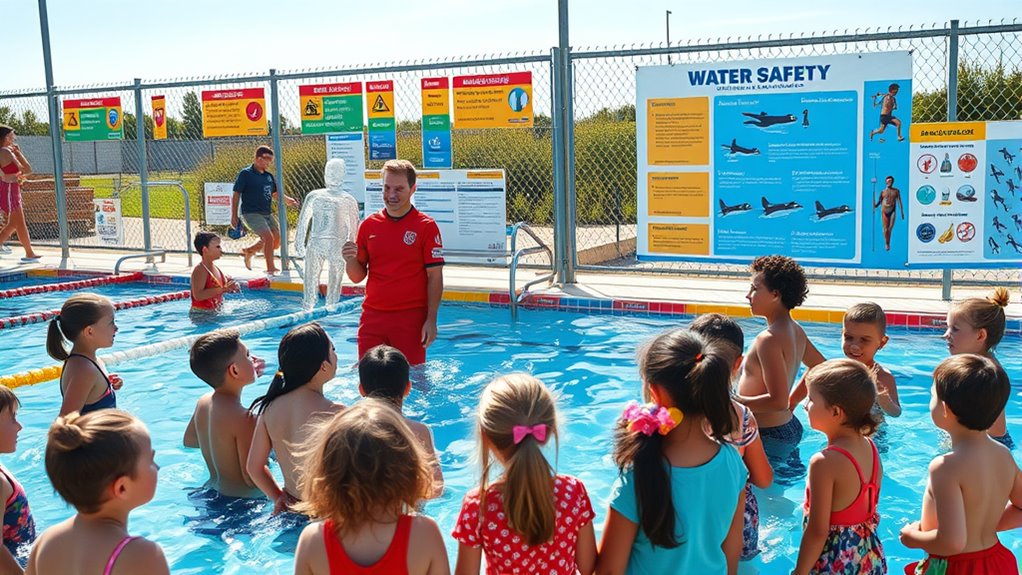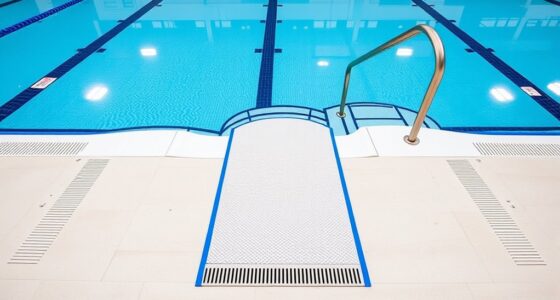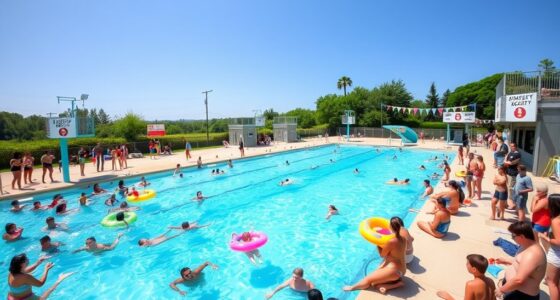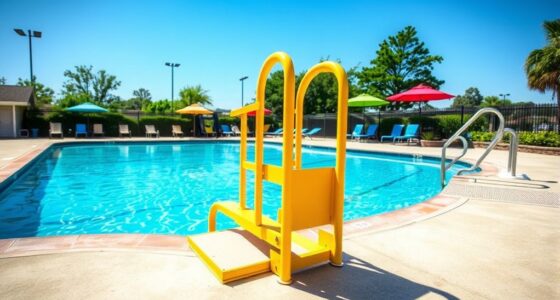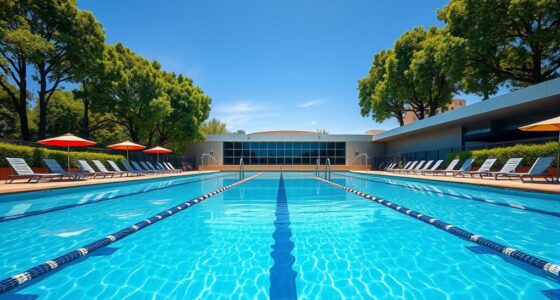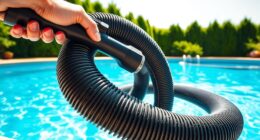Water safety education programs for public pool users focus on helping you recognize hazards, follow safety rules, and respond effectively to emergencies. These programs teach basic water skills like floating and treading water, building your confidence and reducing panic. They emphasize constant supervision and vigilance, especially for children and beginners. By promoting responsible behavior and proper safety practices, these programs create safer environments. Keep exploring to learn more about how these initiatives protect you and others while swimming.
Key Takeaways
- Implement comprehensive swimming and rescue skills training to empower pool users and reduce drowning risks.
- Promote constant supervision and vigilant behavior among parents, caregivers, and swimmers.
- Enforce safety rules such as no running and shallow diving to prevent accidents.
- Educate users on hazard recognition, emergency response, and CPR to ensure preparedness.
- Foster a safety-first culture through signage, policies, and staff training to maintain a secure pool environment.
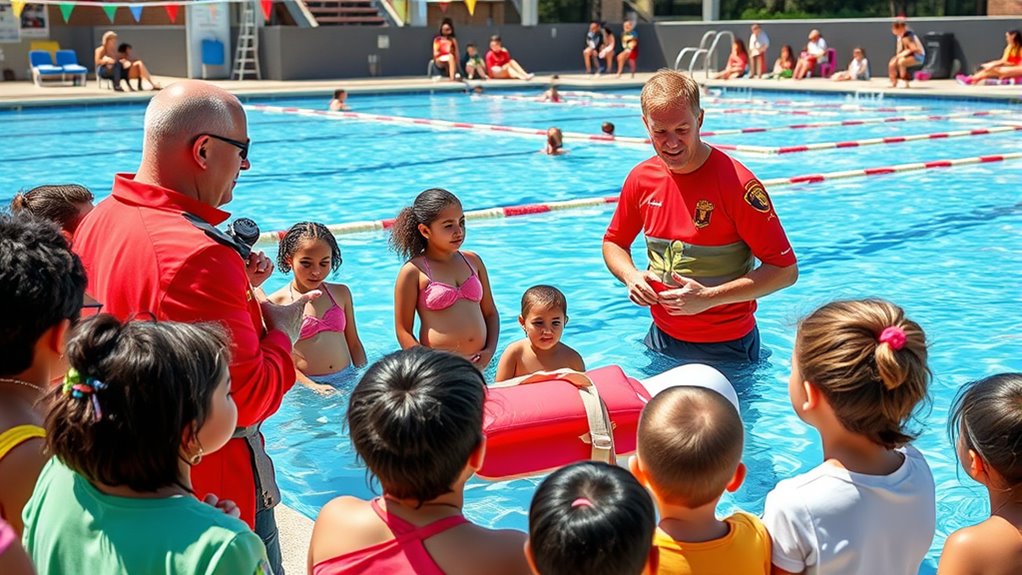
Have you ever wondered how to keep yourself and others safe around water? Water safety education programs are essential tools for guaranteeing that everyone can enjoy public pools while minimizing risks. One of the most effective components of these programs is lifeguard training, which equips individuals with the skills needed to respond quickly and effectively in emergency situations. Lifeguard training emphasizes drowning prevention, teaching trainees how to spot potential hazards, enforce safety rules, and perform rescues when necessary. By understanding the principles behind drowning prevention, lifeguards become proactive in minimizing accidents, ensuring that pool environments remain safe for all users.
Participating in water safety education programs also benefits regular pool users. These programs often include lessons on basic water skills, such as floating, treading water, and safe swimming practices. When you learn these skills, you become more confident and capable in the water, reducing the likelihood of panic or unsafe behavior. Additionally, education programs cover important safety rules, like not running around the pool deck, avoiding diving in shallow areas, and never swimming alone. Knowing and adhering to these guidelines considerably lowers the chance of accidents happening.
Learning basic water skills boosts confidence and safety in the pool.
Another critical aspect of water safety education is raising awareness about the importance of supervision. Even strong swimmers and trained lifeguards cannot prevent every incident if vigilance lapses. These programs typically stress the need for constant supervision, especially for children and inexperienced swimmers. As a pool user, understanding your role in maintaining a safe environment can make a big difference. Whether you’re a parent, caregiver, or fellow swimmer, being attentive and proactive helps prevent drowning and other water-related accidents.
Public pool operators also benefit from extensive water safety education programs. They can implement policies and signage that reinforce safety practices, ensuring that everyone understands the risks involved. Proper training for staff about emergency procedures and first aid, including CPR, ensures a quick response in case of an incident. These measures create a culture of safety that encourages responsible behavior and reduces the likelihood of drowning incidents.
Ultimately, water safety education programs serve as a crucial bridge between knowing how to enjoy water and knowing how to stay safe. Lifeguard training and drowning prevention techniques form the foundation of these efforts. By participating in or supporting these programs, you help foster a safer environment for everyone. Whether you’re swimming, supervising others, or working as a lifeguard, understanding safety protocols makes all the difference. Together, these efforts help guarantee that pools remain enjoyable, safe spaces for recreation and relaxation.
Frequently Asked Questions
How Often Are Water Safety Courses Offered at Public Pools?
Water safety courses at public pools are typically offered seasonally, with programs scheduled weekly or biweekly during peak times like summer. The course frequency varies depending on the pool’s resources and community demand, so check your local pool’s schedule for specific dates. You can usually find program scheduling details on their website or by calling the facility directly, ensuring you don’t miss the opportunity to learn essential safety skills.
Are There Programs Specifically for Non-Swimmers or Beginners?
Imagine the pool as a safe haven—you’re not alone if you’re a non-swimmer or beginner. Yes, many pools offer beginner courses and non-swimmer classes designed to build confidence and safety skills. These programs focus on basic water safety, floating, and breathing techniques. Participating in these classes helps you overcome fear, so you can enjoy the water responsibly and confidently, transforming apprehension into empowerment.
What Age Groups Are Targeted by Current Water Safety Initiatives?
Current water safety initiatives target all age groups, emphasizing the importance of adult supervision for children and clear pool signage for everyone. You should always supervise young kids closely and follow posted signs to understand pool rules. These programs aim to educate both parents and older adults about risks, ensuring everyone knows how to stay safe. By staying vigilant and respecting signage, you help prevent accidents and promote a safer swimming environment for all.
Do Programs Include Training for Pool Staff and Lifeguards?
You’ll find that many programs include training for pool staff and lifeguards. For example, a case study showed a lifeguard preventing a drowning through quick action after completing specialized lifeguard training. These programs emphasize thorough pool staff training, ensuring they understand rescue techniques, CPR, and safety protocols. By investing in lifeguard training, you help create a safer environment, reducing accidents and saving lives at public pools.
Are There Costs Associated With Participating in Water Safety Education?
Yes, there are costs associated with participating in water safety education, but program funding often helps offset expenses. Many programs offer scholarships or sliding scale fees, making training more accessible. You should check with your local pool or community center to see if financial assistance is available. This way, you can get the necessary training without worrying about high costs, ensuring you’re well-prepared for water safety.
Conclusion
So, you’d think learning water safety would be obvious, right? Yet, every year, accidents happen because folks skip the lessons or ignore safety rules. It’s ironic—you’re at a public pool, surrounded by water, yet many of us forget how to stay safe. Investing a little time in education could prevent tragedy and keep everyone enjoying the water. Don’t wait for an accident—teach yourself now, because ignoring safety might be the most dangerous poolside decision you make.
